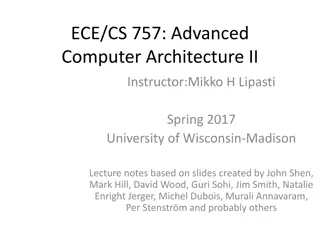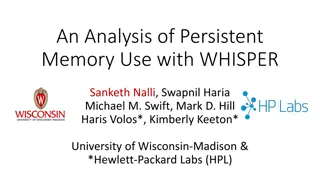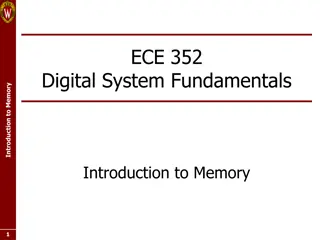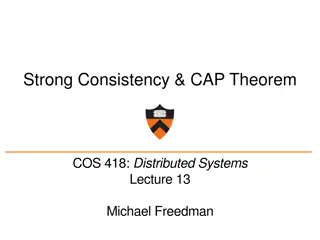Enhancing Storage Consistency in Persistent Memory Systems
Persistent memory systems face challenges with strict write ordering requirements affecting performance. This study introduces Loose-Ordering Consistency to minimize overhead while ensuring storage consistency by leveraging hardware support and innovative commit protocols. Results show a significant reduction in the average performance overhead of persistence ordering. The approach includes Eager Commit and Speculative Persistence techniques.
Download Presentation

Please find below an Image/Link to download the presentation.
The content on the website is provided AS IS for your information and personal use only. It may not be sold, licensed, or shared on other websites without obtaining consent from the author.If you encounter any issues during the download, it is possible that the publisher has removed the file from their server.
You are allowed to download the files provided on this website for personal or commercial use, subject to the condition that they are used lawfully. All files are the property of their respective owners.
The content on the website is provided AS IS for your information and personal use only. It may not be sold, licensed, or shared on other websites without obtaining consent from the author.
E N D
Presentation Transcript
Loose-Ordering Consistency for Persistent Memory Youyou Lu1, Jiwu Shu1, Long Sun1, Onur Mutlu2 1Tsinghua University 2Carnegie Mellon University
Summary Problem: Strict write ordering required for storage consistency dramatically degrades performance in persistent memory Our Goal: To keep the performance overhead low while maintaining the storage consistency Key Idea: To Loosen the persistence ordering with hardware support Eager commit: A commit protocol that eliminates the use of commit record, by reorganizing the memory log structure Speculative persistence: Allows out-of-order persistence to persistent memory, but ensures in-order commit in programs, leveraging the tracking of transaction dependencies and the support of multi-versioning in the CPU cache Results: Reduces average performance overhead of persistence ordering from 67% to 35% 2
Outline Introduction and Background Existing Approaches Our Approach: Loose-Ordering Consistency Eager Commit Speculative Persistence Evaluation Conclusion 3
Outline Introduction and Background Existing Approaches Our Approach: Loose-Ordering Consistency Eager Commit Speculative Persistence Evaluation Conclusion 4
Persistent Memory Persistent Memory Memory-level storage: Use non-volatile memory in main memory level to provide data persistence Storage Consistency Atomicity and Durability: Recoverable from unexpected failures Boundary of volatility and persistence moved from Storage/Memory to Memory/Cache L1 L1 L2 L2 LLC LLC Memory (DRAM) Memory (NVM) Disk Storage Disk Storage 5
Storage Consistency Write-Ahead Logging(WAL) C E F I J J M O P J M M N O O P Step 1. Log Write Intra-tx Ordering Step 2. Commit Record Write Program Ack Step 3. In-place Write Inter-tx Ordering Step 4. Log Truncation Ordering is required for storage consistency. 6
High Overhead for Ordering in PM Persistence ordering Force writes from volatile CPU cache to Persistent Memory L1 L2 Volatile LLC Memory (NVM) Persistent High overhead for persistence ordering The boundary between volatility and persistence lies between the H/W controlled cache and the persistent memory Costly software flushes (clflush) and waits (fence) Existing systems reorder writes at multiple levels, especially in the CPU and cache hierarchy 7
Outline Introduction and Background Existing Approaches Our Approach: Loose-Ordering Consistency Eager Commit Speculative Persistence Evaluation Conclusion 8
Existing Approaches Making the CPU cache non-volatile Reduce the time gap between volatility and persistence by employing a non-volatile cache Is complementary to our LOC approach Allowing asynchronous commit of transactions Allow the execution of a later transaction without waiting for the persistence of previous transactions Allow execution reordering, but no persistence reordering T1: A, B, C, D T2: A, F T3: B, C, E T4: D, E, F, G 1 2 3 L1 1 3 2 4 L1 1 3 2 4 L2 L2 LLC LLC LLC 1 Memory (NVM) Memory (NVM) 9
Our Solution: Key Ideas 1 2 3 4 2 L1 1 3 Loose-Ordering Consistency (LOC) Allow persistence reordering L2 4 LLC 1 3 Memory (NVM) Eager Commit Remove the intra-tx ordering Delay the completeness check till recovery phase Reorganize the memory log structure Speculative Persistence Relax the inter-tx ordering Speculatively persist transactions but make the commit order visible to programs in the program order Use cache versioning and Tx dependency tracking 10
Outline Introduction and Background Existing Approaches Our Approach: Loose-Ordering Consistency Eager Commit Speculative Persistence Evaluation Conclusion 11
LOC Key Idea 1 Eager Commit Step 1. Log Write Intra-tx Ordering Step 2. Commit Record Write Program Ack Step 3. In-place Write Inter-tx Ordering Step 4. Log Truncation Goal: Remove the intra-tx ordering Eager Commit: A new commit protocol without commit records 12
Eager Commit Commit Protocol Commit record: Check the completeness of log writes Eager Commit Reorganize the memory log structure for delayed check Remove the commit record and the intra-tx ordering Use count-based commit protocol: <TxID, TxCnt> 13
Eager Commit Tx1, 0 Tx1, 0 Tx2, 0 Tx1, 0 Tx1, 4 Count-based commit protocol During normal run, Tag each block with TxID Set only one TxCnt to the total # of blocks in the tx, and others to 0 During recovery, Recorded TxCnt: Find the non-zero TxCnt for each tx TxID Counted TxCnt: Count the tot. # of blocks in the tx If the two TxCnts match (Recorded = Counted), committed; otherwise, not-committed No commit record. Intra-tx ordering eliminated. 14
LOC Key Idea 2 Speculative Persistence Step 1. Log Write Intra-tx Ordering Step 2. Commit Record Write Program Ack Step 3. In-place Write Inter-tx Ordering Step 4. Log Truncation Goal: relax the inter-tx ordering Speculative Persistence Out-of-order persistence: To relax the inter-tx ordering to allow persistence reordering In-order commit: To make the tx commits visible to programs (program ack) in the program order 15
Speculative Persistence T1: (A, B, C, D) -> T2: (A, F) -> T3: (B, C, E) -> T4: (D, E, F, G) Strict Ordering volatile CPU cache A A A B B B C C C D D D A A A F F F B B B C C C E E E D D D E E E F F F G G G persistent memory A B C D A F B C E D E F G Loose Ordering volatile CPU cache A A B B C C D D A A A F F B B B C C C E E D D D E E E F F F G G G persistent memory A B C D E F G Inter-tx ordering relaxed. Write coalescing enabled. 16
Speculative Persistence Speculative Persistence enables write coalescing for overlapping writes between transactions. But there are two problems raised by write coalescing of overlapping writes: How to recover a committed Tx which has overlapping writes with a succeeding aborted Tx? Overlapping data blocks have been overwritten Multiple Versions in the CPU Cache How to determine the commit status using the count-based commit protocol of a Tx that has overlapping writes with succeeding Txs? Recorded TxCnt != Counted TxCnt Commit Dependencies between Transactions Tx Dependency Pair: <Tp, Tq, n> See the paper for more details. 17
Recovery Recovery is made by scanning the memory log. More details in the paper. 18
Outline Introduction and Background Existing Approaches Our Approach: Loose-Ordering Consistency Eager Commit Speculative Persistence Evaluation Conclusion 19
Experimental Setup GEM5 simulator Timing Simple CPU: 1GHz Ruby memory system Simulator configuration L1: 32KB, 2-way, 64B block size, latency=1cycle L2: 256KB, 8-way, 64B block size, latency=8cycles LLC: 1MB, 16-way, 64B block size, latency=21cycles Memory: 8 banks, latency=168cycles Workloads B+ Tree, Hash, RBTree, SPS, SDG, SQLite 20
Overall Performance S-WAL H-WAL LOC-WAL LOC-Kiln Kiln Normalized Tx Throughput 1 0.9 0.8 0.7 0.6 (txs/s) 0.5 0.4 0.3 0.2 0.1 0 B+Tree Hash RBTree SPS SDG SQLite Gmean LOC significantly improves performance of WAL: Reduces average performance overhead of persistence ordering from 67% to 35%. LOC and Kiln can be combined favorably. LOC effectively mitigates performance degradation from persistence ordering. 21
Effect of Eager Commit 0.7 Normalized Tx Throughput H-WAL EC-WAL 0.6 0.5 (txs/s) 0.4 0.3 0.2 0.1 0 B+Tree Hash RBTree SPS SDG SQLite Gmean Eager Commit outperforms H-WAL by 6.4% on average due to the elimination of intra-tx ordering. 22
Effect of Speculative Persistence LOC(SD=1) LOC(SD=2) LOC(SD=4) LOC(SD=8) LOC(SD=16) LOC(SD=32) Normalized Tx Throughput 0.9 0.8 0.7 0.6 (txs/s) 0.5 0.4 0.3 0.2 0.1 B+Tree Hash RBTree SPS SDG SQLite Gmean The larger the speculation degrees, the larger the performance benefits. Speculative Persistence improves the normalized transaction throughput from 0.353 (SD=1) to 0.689 (SD=32) with a 95.5% improvement. 23
Outline Introduction and Background Existing Approaches Our Approach: Loose-Ordering Consistency Eager Commit Speculative Persistence Evaluation Conclusion 24
Conclusion Problem: Strict write ordering required for storage consistency dramatically degrades performance in persistent memory Our Goal: To keep the performance overhead low while maintaining the storage consistency Key Idea: To Loosen the persistence ordering with hardware support Eager commit: A commit protocol that eliminates the use of commit record, by reorganizing the memory log structure Speculative persistence: Allows out-of-order persistence to persistent memory, but ensures in-order commit in programs, leveraging the tracking of transaction dependencies and the support of multi-versioning in the CPU cache Results: Reduces average performance overhead of persistence ordering from 67% to 35% 25
Loose-Ordering Consistency for Persistent Memory Youyou Lu1, Jiwu Shu1, Long Sun1, Onur Mutlu2 1Tsinghua University 2Carnegie Mellon University























